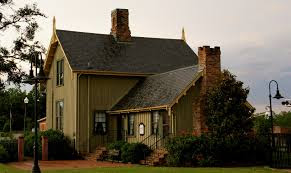 |
| Before guests arrive at McCrady's Restaurant, Chef Kevin Mitchell checks the arrangements in the Long Room. |
Five years ago I attended an amazing event — and after a five-year-long reflection I can now write about it. It was that profound. Held in Charleston, SC, on April 19, 2015, it has become known as Nat Fuller’s Feast.
 |
| Guests at Nat Fuller's Feast get comfortable before the dinner program begins. |
Original Dinner
It commemorated and celebrated the original dinner held by Fuller, a newly freed African-American chef, to mark the end of the American Civil War and of slavery. Charleston, the epicenter of secession, had surrendered to Union forces on February 18, 1865, and their occupation liberated the approximately 10,000 slaves who had remained there.
 |
| Chef B.J. Dennis brings out a tray of hors d'oeuvres at the reception. |
To a feast of his making in his restaurant, Fuller invited prominent citizens, blacks and whites, as his guests. Historian
David Shields identifies the significance of the occasion: “Here’s a man who realizes that because of the abolition of slavery ... there’s going to be a new ground of social relationships.”
 |
| Prof. David Shields (right) with a re-enactor of the 54th Massachusetts Regiment at the reception. |
Abby Louisa Porcher, a grande dame of the Charleston planter society, described the feast this way: “Nat Fuller, a Negro caterer, provided munificently for a miscegenat dinner, at which blacks and whites sat on an equality and gave toasts and sang songs for Lincoln and Freedom.”
 |
| A table display at the reception with a portrait by artist Jonathan Green to communicate the spirit of Nat Fuller (although no pictures of Fuller have been found). |
The 2015 event also recognized the significant role that free and enslaved African-Americans played in shaping Charleston's cuisine in the mid-nineteenth and until World War I. Before being emancipated, Fuller had been an enslaved cook, caterer, marketer of game, and restaurateur, and he was the foremost private chef in the antebellum city. As described by Shields, Fuller was “one citizen who sought to turn the hearts and minds of the public to the future, to teach Charlestonians the values requisite in the new post-bellum world.”
 |
| Advertisement in the Charleston Courier on June 12, 1855 by Nat Fuller, who saved money for his catering business by working as the city's chief marketer of game (courtesy of American Historical Newspapers). |
Reconciliation Renewed
Shields chaired Nat Fuller’s Feast in an attempt to re-create the 1865 meal as part of the city’s Civil War sesquicentennial. Chef Kevin Mitchell of the Culinary Institute of Charleston served as host. Chef B.J. Dennis, a Gullah-Geechee culinary specialist; nationally noted chef Sean Brock (formerly of McCrady’s and Husk); and Mitchell prepared the food with the assistance of many others.
 |
| I enjoyed meeting Natalie Dupree, the Queen of Southern Cuisine, who is an esteemed chef, cooking show host and author of 14 cookbooks. |
The evening began with a reception in
The Charleston Renaissance Gallery, a fine arts gallery where Bachelor’s Retreat, Fuller’s restaurant renowned for its pastries and its roasted game and meats at 78 Church Street (now 103 Church Street), had been located. Hors d’oeuvres — brioche with foie gras mousse, strawberry jam and pickled spring onions; benne tart shells with lobster salad and caviar; warm rice bread with smoked tongue and chow chow; chicken and truffle pies — were as remarkable as the cocktails: brandy smash, mint julep, gin with bitters, persimmon beer, carbonated shrubs as well as Nat Fuller’s signature concoctions.
 |
| A tray of shells with lobster salad is served at the reception. |
During the reception, re-enactors of the 54th Massachusetts Regiment, an African-American regiment in the Civil War made famous in the movie Glory, sang songs of the era. This regiment had entered Charleston three days after the mayor had surrendered the city to Union troops. After the reception, we were escorted by the re-enactors
to the Long Room of
McCrady’s Restaurant for the feast. Food prepared as it was in Fuller’s time came out in waves. In the tradition of Fuller’s banquets, Russian-style service brought courses sequentially rather than all at once, and each waiter served small sections of two long dinner tables.
 |
| Re-enactors of the 54th Massachusetts Regiment escort the dinner guests from the reception to McCrady's Restaurant. |
The Menu
The platters were overflowing:
- Potage: mock turtle soup and oyster soup with celery
- Relishes: mixed pickled vegetables, Bradford watermelon pickles, marinated olives, collard kraut
- Poisson (fish): fried whiting, shrimp pie, poached bass, Worcestershire anchovy sauce, mushroom ketchup, walnut ketchup, butter caper sauce
- Volaille (poultry): capon chasseur, aged duck with Seville oranges, partridge with truffle sauce
- Viande (meat): venison with currant demi, lamb chops with mint sauce, beef a la mode
- Legumes: asparagus, roasted turnips, fresh peas, baby beets, roasted potatoes, Carolina gold rice, potato puree
- Desserts: Charlotte russe, almond cake, blanc mange, punch cakes, vanilla and pineapple ice creams
 |
| The menu reflects dishes prepared by Nat Fuller in the 1860s. |
Several of Fuller’s bills of fare have been preserved. They indicate that he cooked veal more than his peers, liked to fry or poach fish rather than broiling it, and prepared food with mushroom and walnut “catsups” regularly. Near the end of the dinner, Shields led everyone in the toast “To Lincoln and liberty” that was also a part of the 1865 feast.
 |
| Two soups, not one, begin the dinner. |
Guests
The menu itself conveys a sense of how well-designed and fantastic the evening was, and the 80 who attended included community leaders, historians, scholars, faith leaders, culinarians, artists, writers, and others. In attendance was the great-great-granddaughter of stellar caterer Eliza Seymour Lee, a free black woman, who apprenticed Fuller when he was being trained as a cook. Because Fuller didn’t sell tickets to his 1865 feast, the organizers decided to select the guests — who would not pay for their meal, but receive it as a gift — except for six, who would be winners of an essay contest administered by
The Post and Courier, the daily newspaper of Charleston.
 |
| My place setting at the dinner. |
When I learned about the contest, I was compelled to enter — a chance to participate in an evening of history, food, and racial reconciliation was enticing. Entrants were asked to explain why they belonged at the table by referring to “the ideals of hospitality, culinary community and social justice embodied by Fuller and his feast.” I fortunately was one of the six winners, and a
condensed version of my essay was published in
The Post and Courier.
 |
| Guests are randomly seated at one of the two long tables to stimulate conversation. |
Controversy
In 2018 at a conference hosted by the College of Charleston,
Ethan Kytla, a California State University Fresno history professor, refuted the claim that Fuller hosted a reunification banquet in the wake of the Civil War. Nevertheless, the college continues to display its
digital exhibit about Fuller and the 2015 dinner.
 |
| Baby beets are one of the many vegetables served. |
Shields had uncovered details about Nat Fuller and his dinner when researching
The Culinarians, a book published by the
University of Chicago Press. Although Shields acknowledged to
The Post and Courier that his research in documenting the original event was imperfect, he is adamant that “there was a sit-down event where blacks and whites were together.”
 |
| A platter of meats is served Russian-style by the team of waiters. Photo: Jonathan Boncek. |
Reflection
Six days before the dinner, a video of Walter Scott, an African American, being killed by a white police officer was released that further incited racial tensions caused by the shooting earlier that month. Then two months later nine African Americans, including Rev. Clementa Pinckney, were killed by a white gunman at Mother Emanuel A.M.E. Church. Pickney, also a state senator, had been one of the guests at Nat Fuller’s Feast.
 |
| The dinner was held at McCrady's Restaurant in historic downtown Charleston. |
The controversy about the authenticity of the 1865 event notwithstanding, the 2015 feast still has merit — a gathering of fellowship in the spirit of racial reconciliation. That it occurred in Charleston is so meaningful in light of the tragic loss of lives that spring. Attending Nat Fuller's Feast was an amazing experience and causes me to reflect frequently on its significance.
 |
| Each guest received a program about the event and Nat Fuller's life. |
For more information about Nat Fuller’s Feast, see:
 |
| The reception was held at The Charleston Renaissance Gallery where the Bachelor's Retreat, Fuller's famous restaurant, had been located. |
Note: McCrady's Restaurant closed when the coronavirus pandemic occurred in 2020 and did not reopen.






























